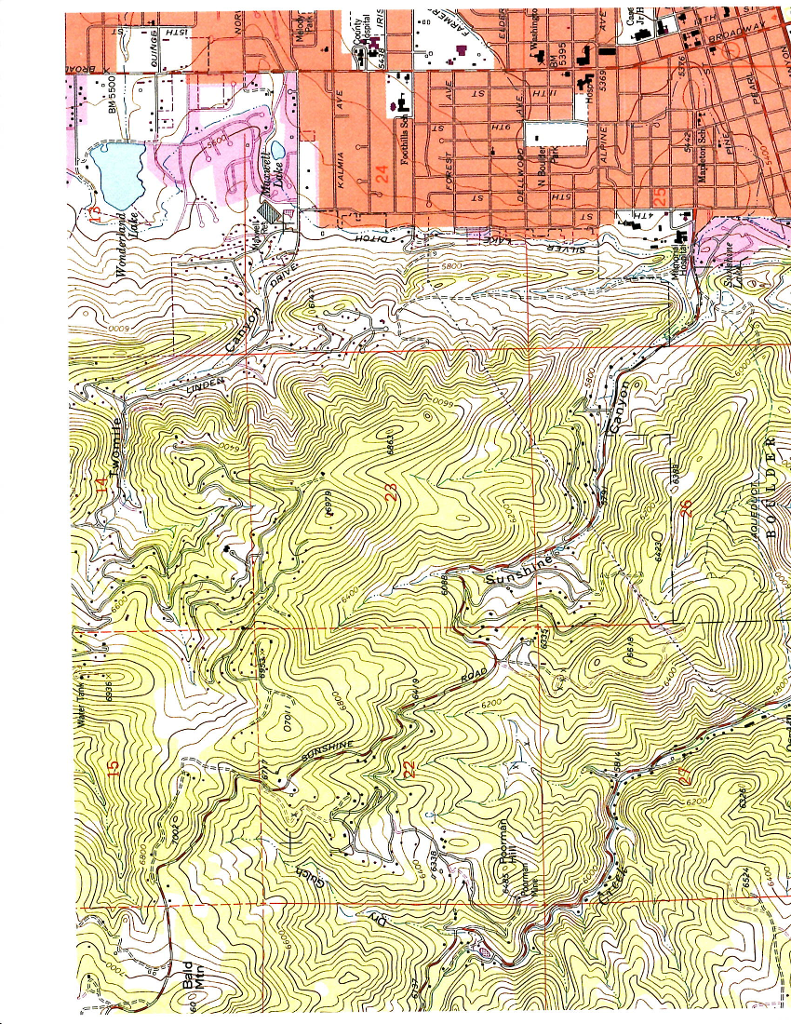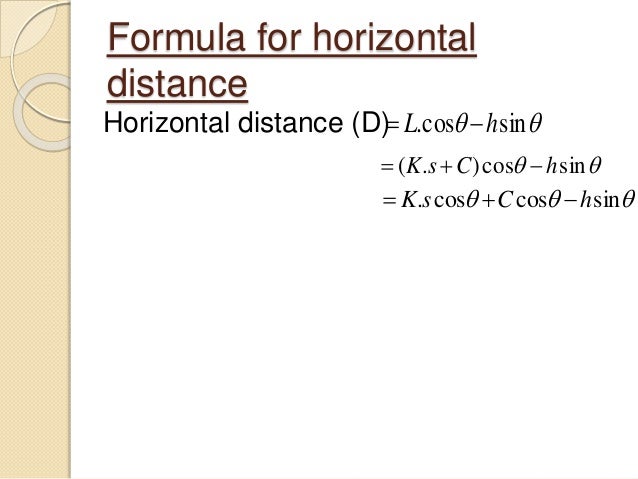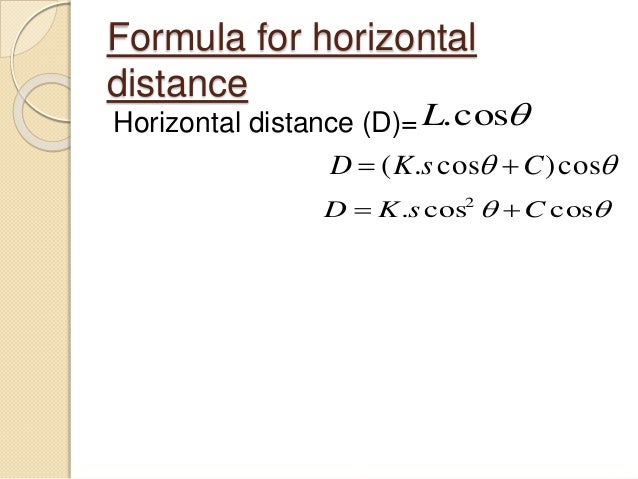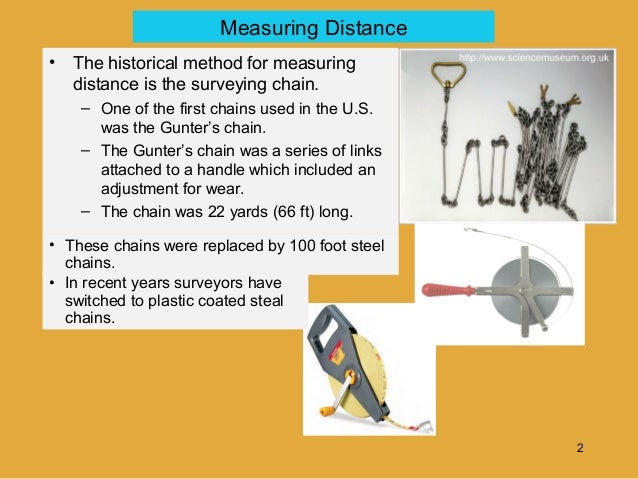In surveying for engineering projects, more sophisticated instruments are employed to maximize accuracy. This method requires at least one assistant to move the staff from place to place. Modern surveying instruments combine a theodolite, EDM equipment, and a computer that records all the observations and calculates the height differences obtained by measuring vertical angles. With increasing precision in distance measurements made by surveyors and engineers, the definition of horizontal warrants reconsideration. For many applications, horizontal distance is obtained as a right‐triangle component of slope distance using a vertical angle.
Horizontal Line Definition In Surveying Since plumb lines converge near the earth's center, and because horizontal and level surfaces are different, a precisely measured slope distance loses its integrity if not reduced correctly. Tables show the similarity of horizontal and level distances and how they differ from the right triangle component of the same slope distance. Two graphs are included to help the reader decide if systematic error caused by ignoring convergence of the plumb lines is significant. Proper reduction of horizontal distance to sea level completes the discussion. Theodolites measure horizontal and vertical angles only. Sometimes they are called tachymeters because we can calculate distances using geometric - trigonometric calculations by angular measurement through a graduated sight.
A theodolite can be mechanical or electronic. A total station can measure angles and distances electronically and process trigonometrically to give us, at a minimum, position coordinates in space. Since the 1980s, electronic distance measurement devices have allowed surveyors to measure distances more accurately and more efficiently than they can with tapes.
To measure the horizontal distance between two points, one surveyor uses an EDM instrument to shoot an energy wave toward a reflector held by the second surveyor. The EDM records the elapsed time between the wave's emission and its return from the reflector. It then calculates distance as a function of the elapsed time. Typical short-range EDMs can be used to measure distances as great as 5 kilometers at accuracies up to one part in 20,000, twice as accurate as taping. Instruments called total stations (Figure 5.14) combine electronic distance measurement and the angle measuring capabilities of theodolites in one unit.
A total station is an electronic theodolite and an electronic distance meter . The horizontal distance is inferred from the vertical angle included between two well-defined points on the staff and the known vertical distance between them. Alternatively, also by readings of the staff indicated by two fixed stadia wires in the diaphragm of the telescope. The difference of height is computed from the angle of depression or elevation of a fixed point on the staff and the horizontal distance already obtained.
The azimuth angle is determined as formerly. The horizontal distance, height difference and bearings are calculated automatically. It can be useful as well if the surveyors don't have an Abney level in hand. Instruments called total stations combine electronic distance measurement and the angle measuring capabilities of theodolites in one unit. Next, we consider how these instruments are used to measure horizontal positions in relation to established control networks.
Horizontal angular measurements are made between survey lines to determine the angle between the lines. A horizontal angle is the difference between two measured directions. When the vertical angle is applied to the slope distance, the horizontal and vertical distances may be calculated. In carrying a level survey, a series of intermediate stations is set up between a bench mark and the new control point to be established. These are occupied by the stadia rod to carry the elevation from one setup to the next, and are called turning points (T.P.).
Horizontal distances for the sights should be made approximately equal by pacing, by stadia measurements, by counting lengths of rails if working along a track, or by some other easy method. The effects of refraction, curvature of the earth, and lack of adjustment of the instrument, are thereby eliminated. On slopes, a zigzag path may be taken to utilize the longer rod length available on the downhill sights.
As you have learned, measuring lines can be ropes, bands, tapes or surveyor's chains. When you measure long distances, the way you use the measuring line will depend on the slope of the terrain. When the terrain is flat or nearly flat (that is, with a slope of 5 percent or less - see Section 4.0), you can measure the horizontal distances by following the ground surface. This method is usually used in measuring fish culture sites, where steeper slopes must be avoided. A disadvantage of plane-table work is that it cannot be checked in the office, and so it requires greater intelligence and integrity of the surveyor. The plane table reached its most efficient form of use in the Survey of India, begun in 1800, in which large areas were mapped with it by dedicated Indian surveyors.
It consists of a flat board that is mounted on a tripod so that it can be fixed or rotated around a vertical axis. It is set up over a framework point or one end of a measured baseline with its surface horizontal. It is turned until the line joining its location with another framework point or the other end of the baseline is parallel to the same line as drawn on the paper. This alignment is performed with the aid of an alidade, or sight rule, a straightedge fitted with simple sights. The alidade is then directed toward points on features that are to be fixed, and pencil rays are drawn along the sight rule toward them. The procedure is repeated at the other framework point or the other end of the baseline; the points where the rays intersect on the table will be the map positions of the features.
To measure distances, land surveyors once used 100-foot long metal tapes that are graduated in hundredths of a foot. Skilled surveyors can achieve accuracies of up to one part in 10,000 . What is vertical distance in surveying? Vertical distances are measured along the vertical axis to determine the difference in height between points. Vertical angles are measured in the vertical plane either above or below the horizontal plane of the instrument.
Location positions are also determined using GNSS. Traditional methods and instruments are still in use in many areas of the world and by users who are not primarily surveyors. Instead of the pole formerly employed to mark a point, a staff similar to a level staff is used.
This is marked with heights from the base or foot, and is graduated according to the form of tacheometer in use. The methods used for fixing locations within the horizontal detail framework are similar to, but less accurate than, those used for the primary framework. Detail points may be located by their distances from two fixed points or by distance and bearing from only one. Surveying topographic profiles involves recording the horizontal location and the elevation of a series of points along the profile . If the instrument is in line with the profile, the upper and lower reticle readings can be used to calculate distance along the profile.
If the instrument cannot be positioned in-line with the profile , then a fibreglass tape can be strung out along the ground surface of the profile. In surveying, the repetition method is used to improve precision and accuracy of measurements of horizontal angles. The same angle is measured multiple times, with the survey instrument rotated so that systematic errors tend to cancel. The arithmetic mean of these observations gives true value of an angle.
Horizontal angles are measured on a plane perpendicular to the vertical axis . Vertical angular measurements are measured to determine slope of survey lines from the horizontal plane . Slope distance can be calculated when the vertical height and the horizontal distance of a right angle are known.
There is a right angle if the vertical and horizontal distances are "true" to the vertical and horizontal, respectively. See the following figure, which denotes x as run and y as rise. To calculate slope distance, you will need a basic scientific calculator with a square root (√z ) function. This is normally done in the fieldbook, back at the field camp, so that original field data and reduced readings can be cross-checked readily.
Chain measurements then become slow and liable to considerable error; the levelling, too, is carried on at great disadvantage in point of speed, though without serious loss of accuracy. These difficulties led to the introduction of tacheometry. Clearly, there is considerable scope for error here.
The effect of small angular discrepancies is magnified, such that the position of E may be subject to considerable error. In such work, very accurate methods of measuring both angles and distances are required. A theodolite with a horizontal circle capable of reading directly to 1 second of arc is preferred.
It is a mechanical device fitted to the vertical circle of a theodolite or to the telescope alidade. It is used to determine horizontal and vertical distances by stadia without reading vertical angles and without the use of stadia tables, diagrams or slide rule. To measure short distances, use a measuring stick called a ruler, 4 to 5 m long. You can make your own by following the steps below. A ruler is particularly useful for measuring horizontal distances on sloping ground.
Shown in figure below, stadia has a focusing screw that causes the objective lens to move, where it is desired to determined the distance D, from the center of the instrument to the rod. When the surveyer looks through the transit scope he can see a vertical and s horizontal line which are called cross hairs. Also, there are two small horizontal lines at the top and bottom of vertical cross hair which are called stadia lines. The difference between those two lines is called stadia interval.
Stadia distance equals the stadia interval times 100. There are two basic methods for measuring distance with a tape. These mathods are slope taping and horizontal taping. In the slope taping method , the slope is held as required by the slope of the ground, the slope of the tape is measured and the horizontal distance is computed.
In the horizontal taping method, the tape is held horizontally and the required graduation is projected on the ground with a plumb bob. An autolevel machine is a professional tool commonly used for precise leveling. It is also used to measure horizontal distances on site.
The method used to find the horizontal distance is known as the 'stadia method'. Auto level is a leveling instrument used in the surveying and construction to measure height differences and to transfer, measure, and set heights of known objects or marks. The ease of use of the auto level has made it popular among surveyors. The mathematical horizontal distance formula is often used on maps because it does not factor in things like peaks, hills and valleys between the two points.
The software stores the adjusted horizontal angle, vertical angle, and slope distance in the point record, as well as an offset record with the offset measurement details. Other forms of tacheometry in surveying include the use of stadia rods with theodolites or plane-table alidades. These use stadia marks on the instrument's reticle to measure the distance between two points on the stadia rod . This is converted to distance from the instrument to the stadia rod by multiplying the stadia interval by the stadia interval factor.
If the stadia rod is not at the same elevation as the instrument, the value must be corrected for the angle of elevation between the instrument and the rod. As demonstrated in the table above, the orthongonal components of a traverse leg can be computed directly from the horizontal and vertical angles using a calculator or spreadsheet. Leica Geosystems TCA reconditioned total stations features ATR objective recognition system.
ATR recognition is achieved quickly and easily. Thanks to this technology it is possible to perform measurements automatically with a computer's help. The most common application of this feature is the accurate controlling construction machinery guide. When plotting a construction floor plan, point position and height are determined by measuring angles and distances.
The instrument is placed on a point referred to a local coordinate system. For orientation purposes, a second point that is easy to distinguish is chosen after visaing it with the horizontal circle set to zero. With such an instrument a sideways movement of the target of one centimetre can be detected at a distance of two kilometres. Automatic level or auto is an optical instrument that is used to set up or substantiate points in the similar horizontal plane.
It is applied in surveying and building along with a vertical staff to calculate height variations as well as transfer, determine and set heights. Setout measurement is used to Setout the required point. The equipment used with this method includes a highly technical sighting device called a telescope. To use it, you must sight through two crossed hairs; there are also two extra horizontal hairs called stadia hairs. Most surveyor's levels (see Section 5.8) have these stadia hairs at an equal distance above and below the horizontal cross-hair.
The second difference is that in ground survey different techniques and accuracies may be adopted for the horizontal and vertical measurements, the latter usually being more precise. Another method is the dynamic taping. Just like in slope taping, the taping is done along the slope, but this time, the vertical angle is measured with a transit. Then, the horizontal distance is computed.
Example 4- Find the slope distance for the vertical and horizontal distances illustrated in the figure below. To use the preceding methods, you must be able to walkover the whole length of each straight line and take direct measurements. Sometimes, however, there is an obstacle on the line that makes measuring the distance directly impossible. Such a line could be across a body of water such as a lake, a lagoon or a river, or across agricultural fields with standing crops. In these cases, you must take indirect measurements of a segment of the line.





















No comments:
Post a Comment
Note: Only a member of this blog may post a comment.